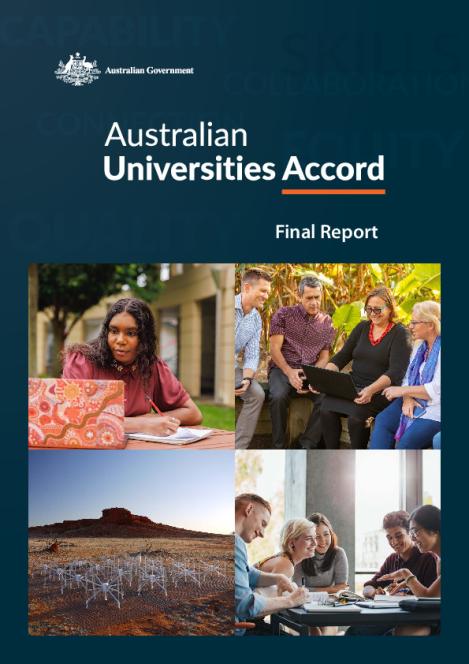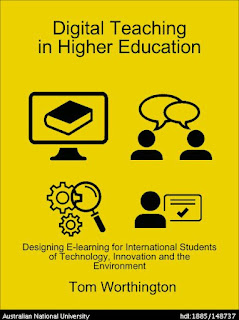The Australian Universities Accord Panel, chaired by Professor Mary O’Kane, has released a 408 page final report (25 February 2024). Some of the suggestions I made in my submission (and no doubt many others made), found their way into the report).There is also a Summary Report by the Department of Education, which at 34 pages is longer than the executive summary in the actual report, so seems a bit pointless (unless the department just wanted to put its own spin on things).
The report, while mentioning democracy and civic values, emphasizes the economic benefits of research and higher education. It raises issues of low demand from students, casualisation of the university workforce, and financial pressures. Equity also features prominently. The report makes 47 recommendations to address these, and other, issues.
Targets and VET
The recommendations under broad headings, the first of which is the "National Tertiary Education Objective". Interestingly this is proposed for both higher and vocational education, to:
a. "underpin a strong, equitable and resilient democracy
b. drive national economic and social development and environmental sustainability."
Vocational education is mentioned further in the Attainment targets:
a. "a skilled workforce to meet the changing needs of the economy through a tertiary education attainment target of at least 80% of the working age population with at least one tertiary qualification (Certificate III and above) by 2050 compared with 60% in 2023
b. growth in Commonwealth supported places in higher education to achieve this target, more than doubling the number of students in Commonwealth supported places from around 860,000 in 2022 to 1.8 million in 2050 across all age groups
c. growing numbers of younger Australians with a university education, through an attainment target of 55% of 25 to 34-year-olds with a bachelor degree qualification or above by 2050 compared with 45% in 2023, noting that many will also have a VET qualification
d. a strong and growing contribution to tertiary attainment driven by TAFE and the vocational system, with a planning assumption that 40% of 25 to 34-year-olds will have a tertiary level vocational or technical qualification in 2050, noting that some people have both a VET and higher education qualification ..."
As it happens, in my submission to the accord panel, I suggested an 80% vocational target but at a more ambitions Certificate IV level, rather than Certificate III. The panel's proposed target of 55% of young people with a bachelor degree may seem modest, given this is already at 45%. However, we may have already past peak degree, with enrollments dropping, as young people decide a degree is not their best investment. Government would do well to agree with this assessment, and decide to fund more flexible forms of education, rather than traditional bachelors degrees.
Flexible Courses and RPL
Under "A more flexible and responsive skills system" the panel recommends "working with tertiary education providers, industry and business to adopt a consistent, published, national approach to recognition of prior learning (RPL) and credit recognition":
i."address historical, cultural and institutional barriers to RPL and credit recognition
ii.make it easier for students to gain maximum credit for previous study and minimise
the time taken and cost to get a new qualification
iii.include recognising appropriate work experience
iv.improve student mobility to enter, exit and return to tertiary education"
While RPL is routine in VET, the difficulty will be in persuading and educating the university sector in how to do it. While universities could learn much from the VET sector, it will be difficult for the upper end of the university sector to accept this. Part of my day job for several years has been processing applications for credit for prior study, & RPL. This is something I have been formally trained to do in TAFE, & university programs, and though being on the accreditation standards board of my profession, but is not a skill many of my colleagues share, or value. Many universities in Australia share course designs across institutions, and international, where external professional recognition imposes standardization. However, this is not formally recognized, so a time consuming process is required to process every application for every course credit. This could be improved by giving incentives to universities to work together, and train staff.
The panel recognize the need for more flexible qualifications, with a recommendation for modular, stackable qualifications:
"5. That to help Australians quickly get the skills they need to fill jobs that are in shortage, the Australian Government establish a comprehensive system of modular, stackable and transferable qualifications, including microcredentials, consistent with a reformed Australian Qualifications Framework." (Page 19)
This one recommendation is worth a whole report in itself. In my submission, I recommended nested programs, rather than the more ambitious stackable. There is a subtle difference here. A university can create a set of qualifications which a student can undertake in sequence (nested). It is much harder to allow the student to assemble a larger qualification from an assortment of smaller ones (stackable). Even the much easier task of providing standalone micro-credentials is one that universities have been slow to achieve. The level of educational design skills would need to be considerably increased at Australian universities to achieve this aim.
Work Integrated Learning
The panel proposes to have studnts "earn and learn while studying" with a "Jobs Broker" for relevant part-time work, paid by employers.
"7. That to ensure students develop work relevant skills for employment after their study, the Australian Government increase opportunities for students to both earn and learn while studying by:
a. establishing a national brokerage system (‘Jobs Broker’) to support tertiary education students find part-time work and placements relevant to their fields of study. Delivery should be through a provider that charges paid subscriptions by employers. The service should be free for students, and allow them to earn income while studying and reduce cost of living pressures
b. promoting work-integrated learning (WIL) by working with peak bodies for employers, industry, business and tertiary education providers to deliver more WIL opportunities in curricula across all disciplines, and provide training to industry supervisors
c. improving measures of graduate generic skills as part of the Graduate Outcomes Survey and Employer Satisfaction Survey. The Australian Tertiary Education Commission should showcase best practice as part of its ‘State of the Tertiary Education System’ annual report
d. using models like degree apprenticeships that encourage an employment relationship as part of course design." (Page 19)
Again this is a recommendation which deserves a whole report itself, with implications for how higher education is provided. For students to be engaged in significant part time work requires them to be part time students. Flipping the Australian university system from a focus on full time study, to part time would seem radical, but is just a recognition of what has already happened. Much of the stress for students and staff comes from students who are holding down a job while studying full time.
For the last eight years I have been helping teach students undertaking Work Integrated Learning, mostly in groups, but also individual interns. Even in the vocationally orientated filed of computing, during a boom in demand for skills in areas such as cyber security, analytics, and AI, this is not easy. Outside vocationally orientated disciplines, such as computing, engineering, and business, this is going to be especially difficult. There is then the problem of training academic staff to design, teach and assess WIL.
Professional Accreditation
The Panel's recommendations on "Professional accreditation bodies", were slightly jarring for someone who has served on accreditation setting committees. As a member of my profession, I am used to telling universities, and governments, what they have to do, not the other way around.
"9. That to ensure professional accreditation including placement requirements are appropriate for industry and business skill needs, tertiary education providers and the Australian Government, through the Australian Tertiary Education Commission, work with professional accreditation bodies, to agree a code of conduct for these bodies. The code should ensure that any accreditation requirements are evidence-based and proportionate to the gain they provide and that placement requirements ensure that students gain industry relevant skills and experience without imposing onerous placement length and conditions." Page 20
That accreditation requirements should be evidence based is reasonable, and work placements not onerous. However this should be a mutual obligation, with the universities required to show they are teaching & assessing work relevant skills.
One example of where WIL assessment can go wrong is with e-portfolios. Students are told to reflect on what they learned on their placement, without training in how to write reflectively. The approach I have been using for the last few years is to frame the reflective e-portfolio in the form of an application for a job, so it is relevant to the student, and have the careers staff teach this.
Participation targets for First Nations, Low SES, Regional, Rural, Remote and Students with a Disability
In recommendation 10, the panel proposes participation targets for undergraduate university students by 2035: 3.3% First Nations, 20.2% low SES, 24.0% regional, rural, and remote, and current rate for students with disability. These are very modest targets, but even so no penalties for non-achievements, or incentives are proposed. Also by emphasizing university this may not be be in the best interests of studnts woH might benifit from attending VET first.
Building aspiration including through increasing readiness for tertiary education and providing career advice
In Recommendation 11, the panel proposes work by federal, and state governments on "... outreach programs designed to develop familiarity with tertiary education". Harder is to "... ensure post-school pathways are visible and integrated into secondary schooling ...".
Fee-free preparatory courses
The Panel calls for free university preparatory courses. One way to fit this in the current system, I suggest, would be to have the preparatory courses run by the VET sector.
Support to participate and succeed in learning
In recommendation 13 the Panel proposes funding for under-represented groups, to meet the targets set in Recommendation 10. It would have been a bit easier to follow the recommendations, if these had been together. No specific amounts are mentioned, or if this additional funding is to come out out of that already provided to universities. Also there is no mention of developing curricular, materials, delivery techniques to suit these students. As an example, it is likely many of the studnts would benifit from blended programs, delivered in part remotely at home, and on country. Also the content of courses may need to be different. Such course content and delivery techniques would also greatly enrich the leanring experience of other students.
Financial support for placements
The panel proposes in recommendation 14 government funding for work placements in nursing, care and teaching professions. The argument presented, that this would reduce financial hardship, makes no sense, unless the government support is extended to all disciplines.
Student income support
In recommendation 15 the panel asks the federal government increasing allowances and loosening rules. Hard to argue with that, except perhaps to suggest abolishing some of the rules.
Reducing student contributions and reforming HELP repayment arrangements
Of most interest to students will be the panels recommendation 16, to reduce the burden of HELP loans, and in particular the effect of the Job-ready Graduates (JRG) package. At the time it was introduced, many warned charging humanities students as a way to direct them to what the then government saw as more vocationally relevant programs would not work. It did not work, and the studnts should not be further punished for past bad government policy.
While previous recommendations were not specific about money, recommendation 17 proposes universities charging "high fees" (over $40,000) for graduate coursework (I assume a Masters), "be required to re-invest a proportion of income earned back into scholarships and bursaries to support students from under-represented backgrounds to access these courses". This Robinhood approach doesn't appear to be proposed for undergraduate courses, or for international student fees. Also it is a relatively mild levy, being retained within the institution.
Ensuring student safety and experience
The Panel calls for a National Student Ombudsman to handle complaints in recommendation 18. The Australian Government recently announced such an office would be established. It is usual for an industry ombudsman to be funded by the industry members, but there is no mention of funding in the announcement.
More controversial is recommendation 19, calling for student unions funded from student fees. This would go counter to the previous government's approach of cutting off funding to student unions. As an online student for seven years, I was slightly annoyed by services and amenities charges, when they went to the upgrading of facilities I had never seen, and would never use, because they were a thousand kilometers away.
Early at-school offers
Recommendation 20 reads like a cartel wanting to maintain the market share of its members. The panel recommends "early at-school offers for 2025 and 2026 should not be issued before September" to "maintain the integrity of senior secondary certificates". However, if universities are able to determine which students are likely to succeed at studies without certificates, they do not have integrity. If the certificates are no longer of value to universities, they should be modified to suit other users, such as employers, and VET. This would also certificates to emphasize work relevant skills.
Quality learning and teaching
Recommendation 21 shows the Panel placing hope over available evidence, by suggesting measures to "prepare the higher education sector for growth in student numbers". I suggest a further decrease in domestic student numbers is more likely, and would be a better outcome in terms of public policy. However, in any case I agree with the panel about "using proven innovative learning approaches which embrace online and hybrid teaching modalities". However, what is lacking is any proposal for university teachers being required to be qualified to teach. Paradoxically, while universities teach the highest level teachers they have the lowest requirements for teaching qualifications. The panel is not proposing to change that.
International education
At this point, it is time for a break ...







